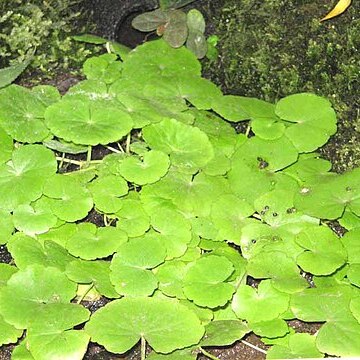Herbs perennial, (20-)30-70(-80) cm tall, glabrous throughout. Rhizomes short, thick, not scaly. Stolons from rhizome or lower to middle stem nodes, to 80 cm. Stems erect, simple, striate angled, 8-15-leaved. Leaves on stolons simple or rarely with a basal pair of auriclelike leaflets; petiole 3-12 mm; leaf blade suborbicular, cordate, or reniform, (0.7-)1-2.2(-3) × 0.7-2(-2.3) cm, margin repand or entire, apex rounded. Cauline leaves sessile, middle ones (1.5-)3-5(-7) cm; terminal leaflet orbicular, ovate, or rarely oblong, 1-3 × (0.8-)1-3 cm, with a petiolule (0.3-)0.5-1.5(-2) cm, base cordate, subtruncate, or obtuse, margin repand or subentire, apex rounded; lateral leaflets 2-5 pairs, much smaller than terminal one, ovate, suborbicular, or oblong-ovate; proximal pair of lateral leaflets auriclelike, attached at or just above node, often giving appearance of amplexicaul leaf base. Fruiting pedicels (0.7-)1-2(-2.5) cm, slender, divaricate, usually straight. Sepals ovate, 3-3.5 × 1-1.5 mm, margin membranous, lateral pair subsaccate. Petals white, obovate, 7-10 × 3-4 mm, not clawed, apex rounded or emarginate. Filaments slightly spreading, median pairs 4-5 mm, lateral pair 2.5-3.5 mm; anther narrowly oblong, 1-1.5 mm. Ovules 14-18 per ovary. Fruit linear, strongly flattened, (1.5-)2-3(-3.5) cm × 1.5-2 mm; valves smooth, glabrous; styles slender, 1.5-3 mm. Seeds brown, oblong, 2-3 × 1-2 mm, winged all around; wing to 1 mm wide. Fl. Apr-Jun, fr. May-Jul.
More
A cabbage family herb. It grows up to 70 cm tall. It has creeping runners. The leaves are of 2 forms. Those on the creeping stems are simple and oval and wavy along the edges. The leaves along the stems are compound with leaflets along the stems. The leaves are alternate and 5 cm long. They are rounded or kidney shaped and let light through. The leaf stalks are thin. The flowers are small and have white petals. The pods are narrow and compressed. They are 3 cm long by 2 mm wide. They have a beak. The seeds are in a row. They are 2 mm long and have wings.

